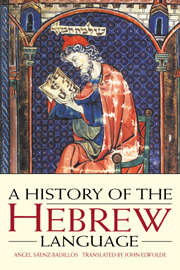Book contents
- Frontmatter
- Contents
- Foreword by Shelomo Morag
- Acknowledgements
- 1 Hebrew in the context of the Semitic languages
- 2 Hebrew, a Northwest Semitic language
- 3 Pre-exilic Hebrew
- 4 Biblical Hebrew in its various traditions
- 5 Hebrew in the period of the Second Temple
- 6 Rabbinic Hebrew
- 7 Mediaeval Hebrew
- 8 Modern Hebrew
- Bibliography
- Index
7 - Mediaeval Hebrew
Published online by Cambridge University Press: 05 June 2012
- Frontmatter
- Contents
- Foreword by Shelomo Morag
- Acknowledgements
- 1 Hebrew in the context of the Semitic languages
- 2 Hebrew, a Northwest Semitic language
- 3 Pre-exilic Hebrew
- 4 Biblical Hebrew in its various traditions
- 5 Hebrew in the period of the Second Temple
- 6 Rabbinic Hebrew
- 7 Mediaeval Hebrew
- 8 Modern Hebrew
- Bibliography
- Index
Summary
Historical and geographical background
It is not easy to establish precise boundaries for that stage of the Hebrew language generally known as Mediaeval Hebrew (MH). We have already said that RH stopped being used as a living vernacular around the end of the second century CE, surviving for several centuries, however, alongside Aramaic, as a literary language. Although the transition to MH cannot be clearly defined, sometime during the sixth to seventh centuries and with the advent of Arab domination, there was a first movement towards the revitalization of Hebrew which may be considered as marking the beginnings of MH, even though the language remained deeply rooted in its past. This was the heyday of the Palestinian payṭanim, liturgical poets who employed a highly idiosyncratic, prayerlike language pervaded by biblical allusion and neologism. The same period sees the redaction of some late midrashim and the beginning of Masoretic activity.
The new vitality was limited to Hebrew as a literary language, but this does not mean that the language had disappeared entirely from daily use. Even though across the world Jewish communities tended to adopt the language of the host country for normal communication, they continued to pray and to read the Bible in Hebrew. This means as well that Hebrew must still have been taught in Jewish schools, and the testimonies of various mediaeval travellers show us that the use of the language in conversation had not ceased completely, as there were some communities, admittedly few in number, that used Hebrew in everyday life.
- Type
- Chapter
- Information
- A History of the Hebrew Language , pp. 202 - 266Publisher: Cambridge University PressPrint publication year: 1993



